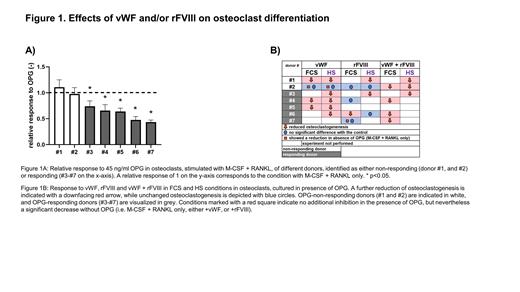Background:
Patients with hemophilia A (HA) commonly exhibit reduced bone mineral density. We hypothesize that osteoclast differentiation may be influenced by the absence of factor VIII (FVIII), as well as other complement-associated proteins such as von Willebrand factor (vWF). Combinatory effects of vWF and recombinant FVIII (rFVIII) on osteoclast differentiation have been described previously, however the effects of rFVIII or vWF on osteoclast precursors across individual donors in the presence of osteoprotegerin (OPG), an important inhibitor of osteoclast differentiation, have not been systematically addressed.
Aim: The main aim of this study is to investigate the effect of vWF, FVIII, or a combination of both factors, on osteoclastogenesis (induced by receptor activator of NF-κB ligand, RANKL) in differentiating osteoclasts from individual human donors, in the presence or absence of OPG.
Methods:
CD14+ monocytes (osteoclast progenitors) were isolated from male healthy donors and cultured for 11 days in medium with 10% fetal calf serum (FCS), according to established protocols. The response of these osteoclast precursors to RANKL and OPG was measured by culturing them under the following conditions: macrophage colony-stimulating factor (M-CSF) (25 ng/ml), M-CSF + RANKL (60 ng/ml) and M-CSF + RANKL + OPG (concentration range 30-60 ng/mL) with cells from each donor. Cells were stained for presence of tartrate-resistant acid phosphatase (TRAP), actin ring, and number of nuclei, and the osteoclast-occupied surface was measured using a semi-automated imaging and analysis protocol. Subsequently, cells were cultured either in 10% human serum (HS) or 10% FCS and exposed to vWF (5 or 10 IU/mL), rFVIII (10 IU/mL), or both vWF + rFVIII for 7, 11 or 14 days in the presence of M-CSF, RANKL and OPG. Morphology was assessed by the aforementioned stainings, TRAP enzymatic activity was determined in the cell culture supernatant, and cathepsin K (CATK) expression was measured using qPCR. The potential of vWF and/or rFVIII to decrease osteoclastogenesis in the presence of OPG was measured through osteoclast-occupied surfaces or osteoclast numbers, with or without TRAP enzymatic activity and/or CATK expression. Donors were categorized as OPG-responding or OPG-non-responding based on the relative reduction of osteoclast formation in the presence of OPG.
Results:
The initial response to RANKL and OPG was determined in 7 donors. Two OPG-non-responding (donors #1 and #2) and 5 OPG-responding donors (donors #3-7) were identified (Figure 1A). Most donors showed a reduced osteoclastogenesis in presence of OPG and vWF. In donor #2, in whom osteoclastogenesis in the presence of OPG was already low, a further reduction by vWF could not be achieved. Of note, a clear inhibition was observed in this donor without OPG (Figure 1B). The effects of rFVIII were more donor-dependent than those with vWF or vWF + rFVIII, with 4 of 7 donors showing reduced osteoclastogenesis. The results were influenced by the type of serum (HS or FCS) used.
In all donors, and irrespective of the medium type, the combination of vWF + rFVIII reduced osteoclast formation, indicating a potentially beneficial effect of vWF + rFVIII compared with vWF or rFVIII alone (Figure 1B).
Conclusion:
Under inhibitory conditions (i.e. in the presence of OPG), rFVIII and vWF (alone or combined) decreased osteoclastogenesis in vitro. This may indicate that vWF and rFVIII, either alone or in combination, can influence the potency of OPG to inhibit osteoclastogenesis. However, this effect was not consistent in all donors. Currently, we are looking into the mechanisms that may explain the differential behavior of osteoclasts derived from OPG-responding and OPG-non-responding donors, as well as studying these effects in cells from patients with HA. We speculate that the absence of FVIII may lead to less efficient inhibition of OPG and increased osteoclastogenesis, which could explain lower bone mineral density observed in HA.
Disclosures
Kimenai:Octapharma: Other: Mrs. Kimenai's salary is compensated in full by Octapharma, Research Funding. Botter:Octapharma: Consultancy, Research Funding.


This feature is available to Subscribers Only
Sign In or Create an Account Close Modal